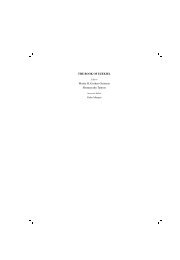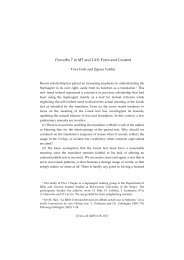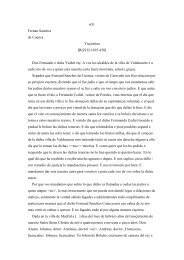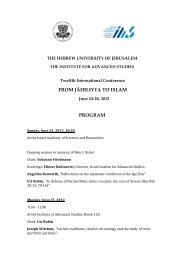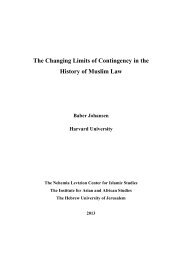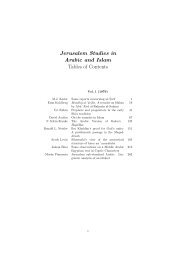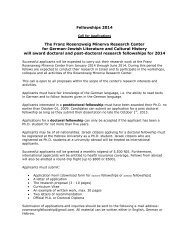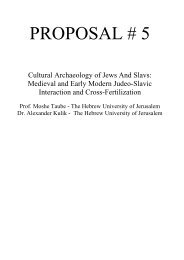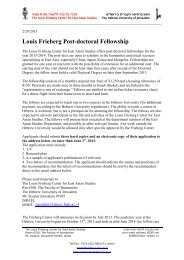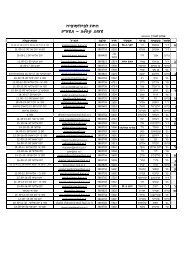Twentieth-Century Russian Literature. Selected Papers from the ...
Twentieth-Century Russian Literature. Selected Papers from the ...
Twentieth-Century Russian Literature. Selected Papers from the ...
Create successful ePaper yourself
Turn your PDF publications into a flip-book with our unique Google optimized e-Paper software.
16<br />
12. RESURRECTION<br />
* Tanya and Evgraf Zhivago (XVI,3:494)<br />
Lara is eliminated by <strong>the</strong> state, and, outside <strong>the</strong> LC, Yurii diagnoses his heart disease as <strong>the</strong><br />
direct consequence of <strong>the</strong> 'constant, systematic hypocrisy' which is required by <strong>the</strong> new regime<br />
(467). They are unable to survive in <strong>the</strong> Bolshevik state, and <strong>the</strong> latter is to be blamed for <strong>the</strong>ir<br />
deaths. However, two members of <strong>the</strong>ir family who did survive emerge in <strong>the</strong> epilogue, : <strong>the</strong>ir<br />
daughter Tan'ka Bezocheredeva meets Yurii's half-bro<strong>the</strong>r Evgraf. One can see this meeting as a<br />
posthumous contact of Yurii and Lara, since both surviving Zhivagos resemble Yurii and Lara;<br />
Tania smiles like Yurii, while Evgraf, in <strong>the</strong> end, is identified with Lara.<br />
The meeting of Tania and Evgraf hints at a tentative resurrection 13 and reunion of <strong>the</strong> heroes.<br />
Two contrasting versions of <strong>the</strong>ir adjustment to <strong>the</strong> new state are suggested here: <strong>the</strong> power of<br />
<strong>the</strong> half-bro<strong>the</strong>r, exotic, elusive and manipulative, who emerges on <strong>the</strong> top of <strong>the</strong> new elite as a<br />
Soviet general, and <strong>the</strong> misery of <strong>the</strong> semi-literate daughter, barely subsisting at <strong>the</strong> bottom of<br />
Communist society. As bleak and unattractive as this resurrection is, it is still <strong>the</strong> future, still a<br />
beacon to survival, maybe <strong>the</strong> only possible one.<br />
3 The Line of Motives<br />
It may be concluded that <strong>the</strong> structure of <strong>the</strong> LC has proved to be far <strong>from</strong> chaotic. A unique<br />
compositional trait of LC lays in <strong>the</strong> unusually persistent isomorphic conjugation of two different<br />
types of textual structures: a chronologically aligned event structure, and an iterational motivic<br />
structure in which <strong>the</strong> manifestations of each motive are adjacent. 14<br />
The alternation of strong and weak events in Table 1.1, is, in fact, nothing less than<br />
organized pulsation within <strong>the</strong> motivic groups. Along <strong>the</strong> LC, <strong>the</strong> pulsation follows an 'echo'<br />
pattern, except for some deviations starting in <strong>the</strong> middle of <strong>the</strong> LC. At <strong>the</strong> same point, <strong>the</strong><br />
motivic groups grow in size, and <strong>the</strong>n, when <strong>the</strong> pulse returns to <strong>the</strong> original pattern, shrink<br />
again. It will be demonstrated below that <strong>the</strong> pulsation changes its rhythm in concert with <strong>the</strong><br />
general composition. In this section, <strong>the</strong> succession of motivic groups along <strong>the</strong> LC will be



